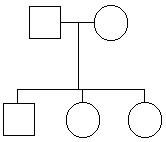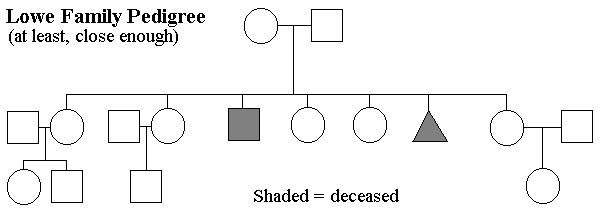Reading Pedigrees
If you're studying genetics, you need to be able to read a genetic pedigree. It's easy when you get the hang of it, but you need to be familiar with the symbols first. Let's start with the basics.
 Most everyone on the planet are either male or female. As these two groups have different genetic make-up, they need different symbols. They're pretty easy to remember. Squares are male and circles are female. If you remember this, you have about 80% of the information you need to study pedigrees.
Most everyone on the planet are either male or female. As these two groups have different genetic make-up, they need different symbols. They're pretty easy to remember. Squares are male and circles are female. If you remember this, you have about 80% of the information you need to study pedigrees.
 After you have genders, you need to connect them into families. To indicate a marriage*, just draw a line connecting a male and a female. If children are produced, a single line is drawn down from the marriage line. If more than one child is present, a horizontal line is drawn below that, and little lines are drawn downward - one for each pregnancy. The drawing on the left represents a family. Although often the father is drawn first, this is only tradition, and it would be correct with the wife first. The children are drawn in order of their births. The family at the left is actually patterned after The Simpsons® on TV.
After you have genders, you need to connect them into families. To indicate a marriage*, just draw a line connecting a male and a female. If children are produced, a single line is drawn down from the marriage line. If more than one child is present, a horizontal line is drawn below that, and little lines are drawn downward - one for each pregnancy. The drawing on the left represents a family. Although often the father is drawn first, this is only tradition, and it would be correct with the wife first. The children are drawn in order of their births. The family at the left is actually patterned after The Simpsons® on TV.
Some families are much more complicated than that. Actually, most families. Let's get a little more complicated. Lets look at a portion of my pedigree.
 Not too bad, is it? There are 15 individuals represented here. The circle and square at the top are my parents. My mother had seven pregnancies. There are two girls, both of whom had children. My oldest sister had a girl and a boy, and my second sister had a boy. Next comes my brother who died just after he was born. Next is me and another sister, then... a triangle???
Not too bad, is it? There are 15 individuals represented here. The circle and square at the top are my parents. My mother had seven pregnancies. There are two girls, both of whom had children. My oldest sister had a girl and a boy, and my second sister had a boy. Next comes my brother who died just after he was born. Next is me and another sister, then... a triangle???
 Triangles represent unknown genders. In this case, it was a miscarriage, but in some old records, a child is mentioned but not whether it wore pink or blue booties. Any unknown is represented as a triangle.
Triangles represent unknown genders. In this case, it was a miscarriage, but in some old records, a child is mentioned but not whether it wore pink or blue booties. Any unknown is represented as a triangle.
Following the triangle is my youngest sister and her family. You may have noticed that none of the brother-in-laws have their families listed. This is because I'm lazy.
My family is a fairly traditional family, but some families get a lot more complicated. Here are some symbols that may come in handy as you're creating a pedigree of your own.
 If you have any other questions regarding pedigrees, please ask me and I will try and help you sort it out.
If you have any other questions regarding pedigrees, please ask me and I will try and help you sort it out.
Sometimes you may want to talk about a special trait that's genetic, such as color blindness. A color blind person would have their shape shaded in. A person who isn't color blind but who carries the gene would be represented by a dot inside their shape. Let's pretend that colorblindness runs in the Simpsons® line. If Bart (the son) was colorblind and Marge (the mom) was a carrier, the pedigree would look like this:

Now that you have learned to read pedigrees, try looking at some larger pedigrees. You'll be seeing them again in a couple weeks.

 Most everyone on the planet are either male or female. As these two groups have different genetic make-up, they need different symbols. They're pretty easy to remember. Squares are male and circles are female. If you remember this, you have about 80% of the information you need to study pedigrees.
Most everyone on the planet are either male or female. As these two groups have different genetic make-up, they need different symbols. They're pretty easy to remember. Squares are male and circles are female. If you remember this, you have about 80% of the information you need to study pedigrees. After you have genders, you need to connect them into families. To indicate a marriage*, just draw a line connecting a male and a female. If children are produced, a single line is drawn down from the marriage line. If more than one child is present, a horizontal line is drawn below that, and little lines are drawn downward - one for each pregnancy. The drawing on the left represents a family. Although often the father is drawn first, this is only tradition, and it would be correct with the wife first. The children are drawn in order of their births. The family at the left is actually patterned after The Simpsons® on TV.
After you have genders, you need to connect them into families. To indicate a marriage*, just draw a line connecting a male and a female. If children are produced, a single line is drawn down from the marriage line. If more than one child is present, a horizontal line is drawn below that, and little lines are drawn downward - one for each pregnancy. The drawing on the left represents a family. Although often the father is drawn first, this is only tradition, and it would be correct with the wife first. The children are drawn in order of their births. The family at the left is actually patterned after The Simpsons® on TV.

 Triangles represent unknown genders. In this case, it was a miscarriage, but in some old records, a child is mentioned but not whether it wore pink or blue booties. Any unknown is represented as a triangle.
Triangles represent unknown genders. In this case, it was a miscarriage, but in some old records, a child is mentioned but not whether it wore pink or blue booties. Any unknown is represented as a triangle.
